Metacognitive Instruction for Sustainable Learning: Learners’ Perceptions of Task Difficulty and Use of Metacognitive Strategies in Completing Integrated Speaking Tasks
Abstract
1. Introduction
2. Literature Review
2.1. Metacognitive Strategies and Metacognitive Instruction
2.2. Learners’ Perceptions of Task Difficulty and Metacognitive Strategy Use
2.3. Metacognitive Strategy Use in L2 Speaking
2.4. Integrated Speaking Tasks
3. Methods
3.1. Research Design
3.2. Participants
3.3. Instruments
3.3.1. The Strategic Competence Inventory for Computer-Assisted Speaking Assessment
3.3.2. Task Difficulty Self-Rating Scale
3.3.3. The Semi-Structured Interview Guide (SSIG)
3.3.4. TOEFL iBT Integrated Speaking Tasks
3.4. Data Collection
3.4.1. Survey Data
3.4.2. Interview Data
3.5. Data Analysis and Results
3.5.1. Learners’ Perceptions of Task Difficulty across Tasks
3.5.2. Learners’ Metacognitive Strategy Use across Tasks
3.5.3. Effects of Learners’ Perception of Task Difficulty on Metacognitive Strategy Use
3.5.4. Interviewees’ Reported Metacognitive Strategy Use in Response to Task Difficulty
4. Discussions
4.1. Metacognitive Strategy Use and Metacognitive Instruction
4.2. Learners’ Perceptions of Task Difficulty and Metacognitive Strategy Use
4.3. Metacognitive Strategy Use in L2 Speaking
5. Conclusions and Implications
5.1. Implications for Metacognitive Instruction
5.2. Implications for L2 Speaking Assessment
6. Limitations and Recommendations for Further Research
Author Contributions
Funding
Institutional Review Board Statement
Informed Consent Statement
Data Availability Statement
Conflicts of Interest
Appendix A. The Strategic Competence Inventory for Computer-Assisted Speaking Assessment (English Version)
- Part One Background Information
- Code:
- Age:
- Gender: Male_□ Female_□ Gender diverse_□
- The years you have been learning English to present:7~9 years_ □ 10~12 years_ □ 13~15 years_□ Others_______.
- English proficiency reflected by testCET4_□ CET6_□_ BEC_□ IELTS_□ TOEFL_□
- Part Two Task Difficulty Self-Rating Scale
| Tasks | This Task is Not Difficult at All | 1 | 2 | 3 | 4 | 5 | 6 | 7 | 8 | 9 | This Task is Extremely Difficult |
| Task 1 | |||||||||||
| Task 2 | |||||||||||
| Task 3 | |||||||||||
| Task 4 |
- Part Three The Strategic Competence Inventory for Computer-assisted Speaking Assessment
| Your Thinking | 0 | 1 | 2 | 3 | 4 | 5 |
| ||||||
| ||||||
| ||||||
| ||||||
| ||||||
| ||||||
| ||||||
| ||||||
| ||||||
| ||||||
| ||||||
| ||||||
| ||||||
| ||||||
| ||||||
| ||||||
| ||||||
| ||||||
| ||||||
| ||||||
| ||||||
| ||||||
|
Appendix B. Semi-Structured Interview Guide (English Version)
- Could you tell me what you did in the planning time for each task?
- Could you tell me whether you had a particular goal before you started your task today?
- Could you tell me whether you completely understood the reading and listening materials in the tests?
- Could you tell me what you did to solve the problems in the tests if you had?
- Could you tell me whether you had evaluated your performance in the test after the task was done?
Appendix C. Coding Scheme
| Categories | Subcategories | Codes | Definitions |
| Metacognitive strategies | Planning | Setting goals | Identify the purpose of the task |
| Directed attention | Decide in advance to focus on the given tasks and ignore distractions | ||
| Activate background | Think about and use what you already know to help you do the task | ||
| Prediction | Anticipate information to prepare and give direction for the task | ||
| Organisational planning | Plan the task and content sequence | ||
| Self-management | Arrange for conditions that help you learn | ||
| Problem-solving | Inference | Make guesses based on previous knowledge | |
| Substitute | Use a synonym or descriptive phrase for unknown words | ||
| Monitoring | Selective attention | Focus on key words, phrases, and ideas | |
| Deduction/induction | Consciously apply learned or self-developed rules | ||
| Personalise/personal experience | Relate information to personal experiences | ||
| Take notes | Write down important words and concepts | ||
| Ask if it makes sense | Check understanding and production to keep track of progress and identify problems | ||
| Self-talk | Talk to yourself to reduce anxiety | ||
| Evaluating | Verify predictions and guesses | Check whether your predictions or guesses are correct | |
| Evaluating performance | Judge how well you do in the task | ||
| Check goals | Decide whether goal was met |
Appendix D. Coding Results
| Subcategory | Interviewees | Metacognitive Strategies |
| Planning | All | Organisational planning (Outlining and organisation) |
| In 4 and In 8 | The activation of prior knowledge | |
| In 2 and In 3 | Setting goals | |
| In 1 and In 3 | Variation in setting goals response to task difficulty | |
| In 4, In 5, In 6, In 7, and In 8 | No particular goals | |
| In 1 and In 3 | Chance of oral practice | |
| Problem-solving | In 6, In 7, In 1, In 2, and In 3 | Inference |
| In 8 | The use of make-up | |
| In 8 | The use of mother tongue | |
| In 8 and In 5 | The use of gap fillers | |
| In 1 and In 7 | Not knowing how to solve problems | |
| In 4 | No problem-solving | |
| Monitoring | In 1 | Taking notes down in a messy manner |
| In 6 | Purposefully taking notes | |
| In 5 | Making predictions and judgments in processing tasks | |
| Evaluating | In 7 and In 8 | Self-evaluation on task completion |
| In 2 and In 6 | Self-evaluation on understanding the tasks | |
| In 7 | Self-evaluation on fluency of his speech | |
| In 1 and In 3 | Self-evaluation on English learning | |
| In 5 | Self-evaluation on his summary of the tasks | |
| All | Self-evaluation on personal feelings | |
| Note. In = Interviewee. | ||
Appendix E. New Themes with Examples
| Categories | Subcategories | Themes | Examples |
| Metacognitive strategies | Planning | No particular goals Chance of oral practice Variance in setting goals based on task difficulty | I had no any goals, and I just thought about finishing the tasks carefully. |
| Well, I just wanted to practice my oral English | |||
| When the tasks became more difficult like Task 3, I felt hard to deal with them. And I had no goals at all. Actually, at the beginning, I had... But when the tasks were not what I expected, I felt stressful and lost all my goals in the end. | |||
| Problem-solving | Not knowing how to solve problems | There was so much information, and if I couldn’t understand the materials given, I had to ignore them and gave them up. | |
| No problems encountered | I don’t think I had problems. You (the researcher) has explained clearly the task requirements …I was very familiar with the test form and the tasks themselves |
Appendix F. Unidentified Assumed Themes
| Categories | Subcategories | Unidentified Codes |
| Metacognitive strategies | Planning | Directed attention |
| Self-management | ||
| Monitoring | Self-talk | |
| Evaluating | Verify predictions and guesses | |
| Check goals | ||
| Evaluating performance |
References
- Zhang, D.L.; Zhang, L.J. Metacognition and self-regulated learning (SRL) in second/foreign language teaching. In Second Handbook of English Language Teaching; Gao, X., Ed.; Springer Nature International: Cham, Switzerland, 2019; pp. 883–897. [Google Scholar]
- Zhang, L.J.; Zhang, D.L. Metacognition in TESOL: Theory and practice. In The TESOL Encyclopedia of English Language Teaching, Vol. II: Approaches and Methods in English for Speakers of other Languages; Liontas, J.I., Shehadeh, A., Eds.; Wiley-Blackwell: Hoboken, NJ, USA, 2018; pp. 682–792. [Google Scholar]
- Seong, Y. Strategic competence and L2 speaking assessment. Teach. Coll. Columbia Univ. Work. Pap. TESOL Appl. Linguist. 2014, 14, 13–24. [Google Scholar]
- Zhang, L.J. Constructivist pedagogy in strategic reading instruction: Exploring pathways to learner development in the English as a second language (ESL) classroom. Instr. Sci. 2008, 36, 89–116. [Google Scholar] [CrossRef]
- Teng, L.S.; Zhang, L.J. Empowering learners in the second/foreign language classroom: Can self-regulated learning strategies-based writing instruction make a difference? J. Second Lang. Writ. 2020, 48, 1–12. [Google Scholar] [CrossRef]
- Zhang, L.J.; Aryadoust, V.; Zhang, D.L. Taking stock of the effects of strategies-based instruction on writing in Chinese and English in Singapore primary schools. In Quadrilingual Education in Singapore: Pedagogical Innovation in Language Education; Silver, R.E., Bokhorst-Heng, W., Eds.; Springer Nature: New York, NY, USA, 2016; pp. 103–126. [Google Scholar]
- Zhang, L.J. A dynamic metacognitive systems account of Chinese university students’ knowledge about EFL reading. TESOL Q. 2010, 44, 320–353. [Google Scholar] [CrossRef]
- Sato, M.; Loewen, S. Metacognitive instruction enhances the effectiveness of corrective feedback: Variable effects of feedback types and linguistic targets. Lang. Learn. 2018, 68, 507–545. [Google Scholar] [CrossRef]
- Ellis, R.; Skehan, P.; Li, S.; Shintani, N.; Lambert, C. Task-Based Language Teaching: Theory and Practice; Cambridge University Press: Cambridge, UK, 2019. [Google Scholar]
- Robinson, P.; Gilabert, R. Task-based learning: Cognitive underpinnings. In The Concise Encyclopedia of Applied Linguistics; Chapelle, C., Ed.; Blackwell: Oxford, UK, 2020; pp. 1046–1051. [Google Scholar]
- Robinson, P.; Gilabert, R. Task complexity, the Cognition Hypothesis and second language learning and performance. Int. Rev. Appl. Linguist. Lang. Teach. 2007, 45, 161–176. [Google Scholar] [CrossRef]
- Révész, A.; Michel, M.; Gilabert, R. Measuring cognitive task demands using dual-task methodology, subjective self-ratings, and expert judgments: A validation study. Studies Second Lang. Acquis. 2016, 38, 703–737. [Google Scholar] [CrossRef]
- Kim, T.; Kim, J. Metacognitive Instruction Using Web 2.0 Technologies in an Adult ESL speaking course. J. Res. Pract. Adult Lit. Second. Basic Educ. 2017, 6, 50–59. [Google Scholar]
- Kormos, J. Speech production and the Cognition Hypothesis. In Second Language Task Complexity: Researching the Cognition Hypothesis of Language Learning and Performance; Robinson, P., Ed.; John Benjamins: Amsterdam, The Netherlands, 2011. [Google Scholar]
- Bygate, M. Teaching and testing speaking. In The handbook of Language Teaching; Long, M.H., Doughty, C.J., Eds.; Wiley: West Sussex, UK, 2011; pp. 412–440. [Google Scholar]
- Luoma, S. Assessing Speaking; Cambridge University Press: Cambridge, UK, 2004. [Google Scholar]
- Barkaoui, K.; Brooks, L.; Swain, M.; Lapkin, S. Test-takers’ strategic behaviours in independent and integrated speaking tasks. Appl. Linguist. 2013, 34, 304–324. [Google Scholar] [CrossRef]
- Cohen, A.D. Strategies in Learning and Using a Second Language; Routledge: London, UK, 2014. [Google Scholar]
- Hung, S.A.; Plakans, L. Topical knowledge in L2 speaking assessment: Comparing independent and integrated speaking test tasks. Lang. Test. 2018, 35, 27–49. [Google Scholar] [CrossRef]
- Frost, K.; Clothier, J.; Huisman, A.; Wigglesworth, G. Responding to a TOEFL iBT integrated speaking task: Mapping task demands and test takers’ use of stimulus content. Lang. Test. 2020, 37, 133–155. [Google Scholar] [CrossRef]
- Skehan, P. Foreign language aptitude, acquisitional sequences, and psycholinguistic processes. In Cognitive Individual Differences in Second Language Processing and Acquisition; Granena, G., Jackson, D., Yilmaz, Y., Eds.; Benjamins: Amsterdam, The Netherlands, 2016; pp. 7–40. [Google Scholar]
- Skehan, P. Second Language Task-Based Performance: Theory, Research, Assessment; Routledge: New York, NY, USA, 2018. [Google Scholar]
- Bachman, L.F.; Palmer, A.S. Language Assessment in Practice: Developing Language Assessments and Justifying Their Use in the Real World; Oxford University Press: Oxford, UK, 2010. [Google Scholar]
- Chamot, A.U.; Harris, V. Language learning strategy instruction for critical cultural awareness. In Learning strategy instruction in the Language Classroom: Issues and Implementation; Chamot, A.U., Harris, V., Eds.; Multilingual Matters: Bristol, UK, 2019; pp. 123–139. [Google Scholar]
- Jumaat, N.F.; Tasir, Z. A framework of metacognitive scaffolding in learning authoring system through Facebook. J. Educ. Comput. Res. 2016, 54, 619–659. [Google Scholar] [CrossRef]
- Dabarera, C.; Renandya, W.A.; Zhang, L.J. The impact of metacognitive scaffolding and monitoring on reading comprehension. System 2014, 42, 462–473. [Google Scholar] [CrossRef]
- An, Y.; Cao, L. Examining the effects of metacognitive scaffolding on students’ design problem solving and metacognitive skills in an online environment. J. Online Learn. Teach. 2014, 10, 552–568. [Google Scholar]
- Cohen, A.D. Moving from theory to practice: A close look at language learner strategies. In Language Learning Strategies and Individual Learner Characteristics: Situating Strategy Use in Diverse Contexts; Oxford, R.L., Amerstorfer, C.M., Eds.; Bloomsbury: London, UK, 2018; pp. 31–54. [Google Scholar]
- Zhang, L.J.; Thomas, N.; Qin, T.L. Language learning strategy research in System: Looking back and looking forward. System 2019, 84, 87–93. [Google Scholar] [CrossRef]
- Flavell, J.H. Metacognition and cognitive monitoring: A new area of cognitive–developmental inquiry. Am. Psychol. 1979, 34, 906–911. [Google Scholar] [CrossRef]
- Flavell, J.H. Cognitive monitoring. In Children’s Oral Communication Skills; Dickson, P., Ed.; Academic Press: New York, NY, USA, 1981; pp. 35–60. [Google Scholar]
- Takeuchi, O. Language learning strategies: Insights from the past and directions for the future. In Second Handbook of English Language Teaching; Gao, X., Ed.; Springer Nature: Cham, Switzerland, 2020; pp. 684–699. [Google Scholar]
- Oxford, R.L. Teaching and Researching Language Learning Strategies; Routledge: New York, NY, USA, 2017. [Google Scholar]
- Plonsky, L. The effectiveness of second language strategy instruction: A meta-analysis. Lang. Learn. 2011, 61, 993–1038. [Google Scholar] [CrossRef]
- Plosky, L. Language learning strategy instructing: Recent research and future directions. In Learning Strategy Instruction in the Language Classroom: Issues and Implementation; Chamot, A.U., Harris, V., Eds.; Multilingual Matters: Bristol, UK, 2019; pp. 3–21. [Google Scholar]
- Goh, C.C. Reconceptualising second language oracy instruction: Metacognitive engagement and direct teaching in listening and speaking. Asian J. Engl. Lang. Pedagog. 2014, 2, 1–20. [Google Scholar]
- Dörnyei, Z. From integrative motivation to directed motivational currents: The evolution of the understanding of L2 motivation over three decades. In The Palgrave Handbook of Motivation for Language Learning; Lamb, M., Csizér, K., Henry, A., Ryan, S., Eds.; Palgrave: Cham, Switzerland, 2019; pp. 39–69. [Google Scholar]
- Cho, M. Task complexity and modality: Exploring learners’ experience from the perspective of flow. Mod. Lang. J. 2018, 102, 162–180. [Google Scholar] [CrossRef]
- Julkunen, K. Situation- and Task-Specific Motivation in Foreign Language Learning and Teaching. Ph.D. Thesis, University of Joensuu, Joensuu, Finland, 1989. Unpublished. [Google Scholar]
- Rahimi, M.; Zhang, L.J. Writing task complexity, students’ motivational beliefs, anxiety and their writing production in English as a second language. Read. Writ. Interdiscip. J. 2019, 32, 761–786. [Google Scholar] [CrossRef]
- Kormos, J.; Wilby, J. Task motivation. In The Palgrave Handbook of Motivation for Language Learning; Lamb, M., Csizér, K., Henry, A., Ryan, S., Eds.; Palgrave: Cham, Switzerland, 2019; pp. 267–286. [Google Scholar]
- Ajzen, I. Perceived behavioural control, self-efficacy, locus of control, and the theory of planned behaviour. J. Appl. Soc. Psychol. 2002, 32, 665–683. [Google Scholar] [CrossRef]
- Horvath, M.; Herleman, H.; Lee McKie, R. Goal orientation, task difficulty, and task interest: A multilevel analysis. Motiv Emot 2006, 30, 169–176. [Google Scholar] [CrossRef]
- Ma, J.H. Autonomy, Competence, and Relatedness in L2 Learners’ Task Motivation: A Self-Determination Theory Perspective. Ph.D. Thesis, University of Hawaii, Hawaii, HI, USA, 2009. Unpublished. [Google Scholar]
- Poupore, G. Measuring group work dynamics and its relation with L2 learners’ task motivation and language production. Lang. Teach. Res. 2016, 20, 719–740. [Google Scholar] [CrossRef]
- Lynch, R.; Hurley, A.; Cumiskey, O.; Nolan, B.; McGlynn, B. Exploring the relationship between homework task difficulty, student engagement and performance. Ir. Educ. Stud. 2019, 38, 89–103. [Google Scholar] [CrossRef]
- Li, W.; Lee, A.; Solmon, M. The role of perceptions of task difficulty in relation to self-perceptions of ability, intrinsic value, attainment value, and performance. Eur. Phys. Educ. Rev. 2007, 13, 301–318. [Google Scholar] [CrossRef]
- Robinson, P. Task complexity, task difficulty, and task production: Exploring interactions in a componential framework. Appl. Linguist. 2001, 22, 27–57. [Google Scholar] [CrossRef]
- Sasayama, S. Is a “complex” task really complex? Validating the assumption of cognitive task complexity. Mod. Lang. J. 2016, 100, 231–254. [Google Scholar] [CrossRef]
- Yahya, M.Y. Improving Speaking Performance and L2 Motivation through Task-Based LANGUAGE Teaching on Malaysian Undergraduate Students. Ph.D. Thesis, The University of Reading, Reading, UK, 2019. Unpublished. [Google Scholar]
- Skehan, P. Researching Tasks: Performance, Assessment and Pedagogy; Shanghai Foreign Language Education Press: Shanghai, China, 2011. [Google Scholar]
- Wang, R.; Liu, Y. Literature review of syntactic priming experiment methods and bilingual speech production models. Adv. Soc. Sci. Educ. Humanit. Res. 2018, 283, 394–398. [Google Scholar]
- Levelt, W.J. Speaking: From Intention to Articulation; MIT Press: Cambridge, MA, USA, 1989. [Google Scholar]
- Creswell, J.W.; Creswell, J.D. Research Design: Qualitative, Quantitative, and Mixed Methods Approaches, 5th ed.; Sage: Los Angeles, CA, USA, 2018. [Google Scholar]
- Zhang, L.M. Metacognitive and Cognitive Strategy Use in Reading Comprehension: A Structural Equation Modelling Approach; Springer Nature: Singapore, 2017. [Google Scholar]
- National Education Examinations Authorities. How to Interpret Scores for College English Test. Beijing, China. 2020. Available online: http://cet.neea.edu.cn/html1/folder/19081/5124-1.htm (accessed on 29 May 2018).
- Rahimi, M. Task Complexity, Affective Factors, and Pre-Task Planning: Effects on L2 Writing Production. Ph.D. Thesis, The University of Auckland, Auckland, New Zealand, 2016. Unpublished. [Google Scholar]
- Kyle, K.; Crossley, S.A.; Mcnamara, D.S. Construct validity in TOEFL iBT speaking tasks: Insights from natural language processing. Lang. Test. 2016, 33, 319–340. [Google Scholar] [CrossRef]
- Pallant, J. SPSS Survival Manual: A Step by Step Guide to Data Analysis Using IBM SPSS, 6th ed.; Allen & Unwin: Sydney, NSW, Australia, 2016. [Google Scholar]
- Craig, K.; Hale, D.; Grainger, C.; Stewart, M.E. Evaluating metacognitive self-reports: Systematic reviews of the value of self-report in metacognitive research. Metacognit. Learn. 2020, 15, 155–213. [Google Scholar] [CrossRef]
- Veenman, M.V.; van Cleef, D. Measuring metacognitive skills for mathematics: Students’ self-reports versus on-line assessment methods. Zdm Int. J. Math. Educ. 2019, 51, 691–701. [Google Scholar] [CrossRef]
- Zhang, W.W.; Zhang, L.J.; Wilson, A.J. Supporting learner success: Revisiting strategic competence through developing an inventory for computer-assisted speaking assessment. Front. Psychol. 2021, 12, 1811. [Google Scholar]
- Dörnyei, Z.; Taguchi, T. Questionnaires in Second Language Research: Construction, Administration, and Processing, 2nd ed.; Routledge: New York, NY, USA, 2009. [Google Scholar]
- Zhang, W.W. Strategic Competence, Task Complexity, and Learner Performance in Computer-delivered Integrated Speaking Test Tasks: A Study of English-as-a-Foreign-Language (EFL) Learners in China. Ph.D. Thesis, The University of Auckland, Auckland, New Zealand, 2021. Unpublished. [Google Scholar]
- ETS (2021): TOEFL iBT® Practice Tests: TOEFL iBT® Practice Sets. Available online: https://www.ets.org/toefl/testtakers/ibt/prepare/tests/ (accessed on 1 May 2019).
- Huang, H.D.; Hung, S.A. Comparing the effects of test anxiety on independent and integrated speaking test performance. TESOL Q. 2013, 47, 244–269. [Google Scholar] [CrossRef]
- Corriero, E.F. Counterbalancing. In The Sage Encyclopedia of Communication Research Methods; Allen, M., Ed.; Sage: Los Angeles, CA, USA, 2017; pp. 278–281. [Google Scholar]
- Frey, B.B. The Sage Encyclopedia of Educational Research, Measurement, and Evaluation; Sage: Los Angeles, CA, USA, 2018. [Google Scholar]
- Richards, L. Handling Qualitative Data: A Practical Guide, 3rd ed.; Sage: Los Angeles, CA, USA, 2015. [Google Scholar]
- Psaltou-Joycey, A.; Gavriilidou, Z. Language Learning Strategies in Greek Primary and Secondary School Learners. In Language Learning Strategies and Individual Learner Characteristics: Situating Strategy Use in Diverse Contexts; Oxford, R.L., Amerstorfer, C.M., Eds.; Bloomsbury: London, UK, 2018; pp. 248–269. [Google Scholar]
- Griffiths, C. The Strategy Factor in Successful Language Learning; Multilingual Matters: Bristol, UK, 2013. [Google Scholar]
- Fazilatfar, A.M. A study of reading strategies using task-based strategy assessment. J. Engl. Lang. Teach. Learn. 2010, 53, 20–44. [Google Scholar]
- Zhou, L. On how to make a breakthrough in teaching Chinese high school EFL learners speaking skill in international schools. Curric. Educ. Res. 2020, 8, 112–113. [Google Scholar]
- O’Malley, J.M.; Chamot, A.U. Learning Strategies in Second Language Acquisition; Cambridge University Press: Cambridge, UK, 1990. [Google Scholar]
- Oxford, R.L.; Cho, Y.; Leung, S.; Hae-Jin, K. Effect of the presence and difficulty of task on strategy use: An exploratory study. Int. Rev. Appl. Linguist. Lang. Teach. 2004, 42, 1–47. [Google Scholar] [CrossRef]
- Yi, J.I. Comparing Strategic Processes in the iBT Speaking Test and in the Academic Classroom. Ph.D. Thesis, The University of Leicester, Leicester, UK, 2012. Unpublished. [Google Scholar]
- Zhang, D.L. Singaporean Secondary School Students’ Metacognitive Knowledge about Oral Communication Skills Learning. Master’s Thesis, National Institute of Education, Nanyang Technological University, Singapore, 2001. Unpublished. [Google Scholar]
- Zhang, D.L. “Your English Is Too Cheem!”: Singaporean Student Listening Difficulties and Tackling Strategies. Asian Engl. 2004, 7, 74–91. [Google Scholar]
- Zhang, D.L.; Goh, C.C.M. Strategy knowledge and perceived strategy use: Singaporean students’ awareness of listening and speaking strategies. Lang. Aware. 2006, 15, 199-119. [Google Scholar] [CrossRef]
- Gurven, M. Broadening horizons: Sample diversity and socioecological theory are essential to the future of psychological science. Proc. Natl. Acad. Sci. USA 2018, 115, 11420–11427. [Google Scholar] [CrossRef]
- O’Sullivan, B. (Ed.) Language Testing: Theories and Practices; Palgrave: Oxford, UK, 2011. [Google Scholar]
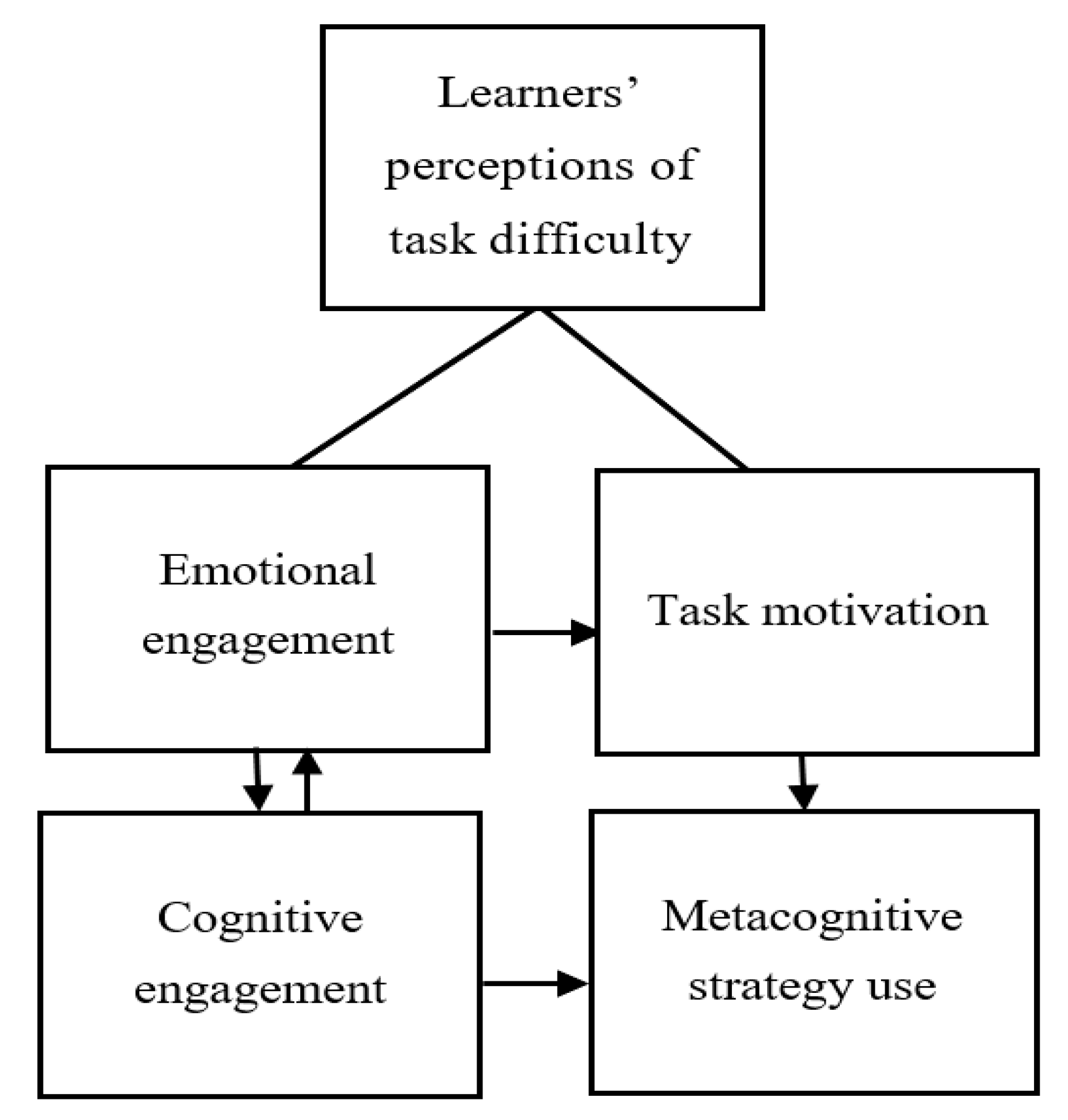
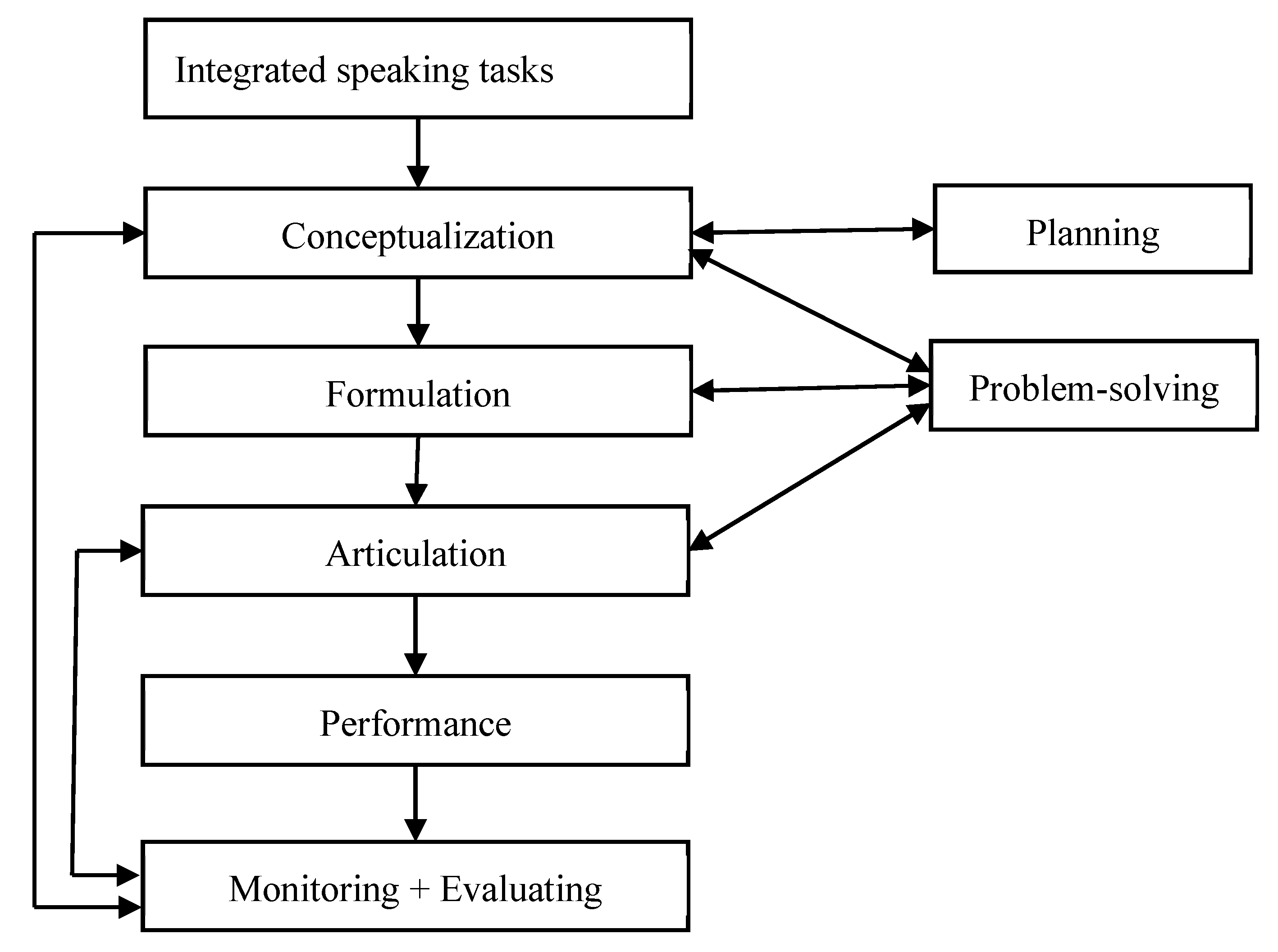
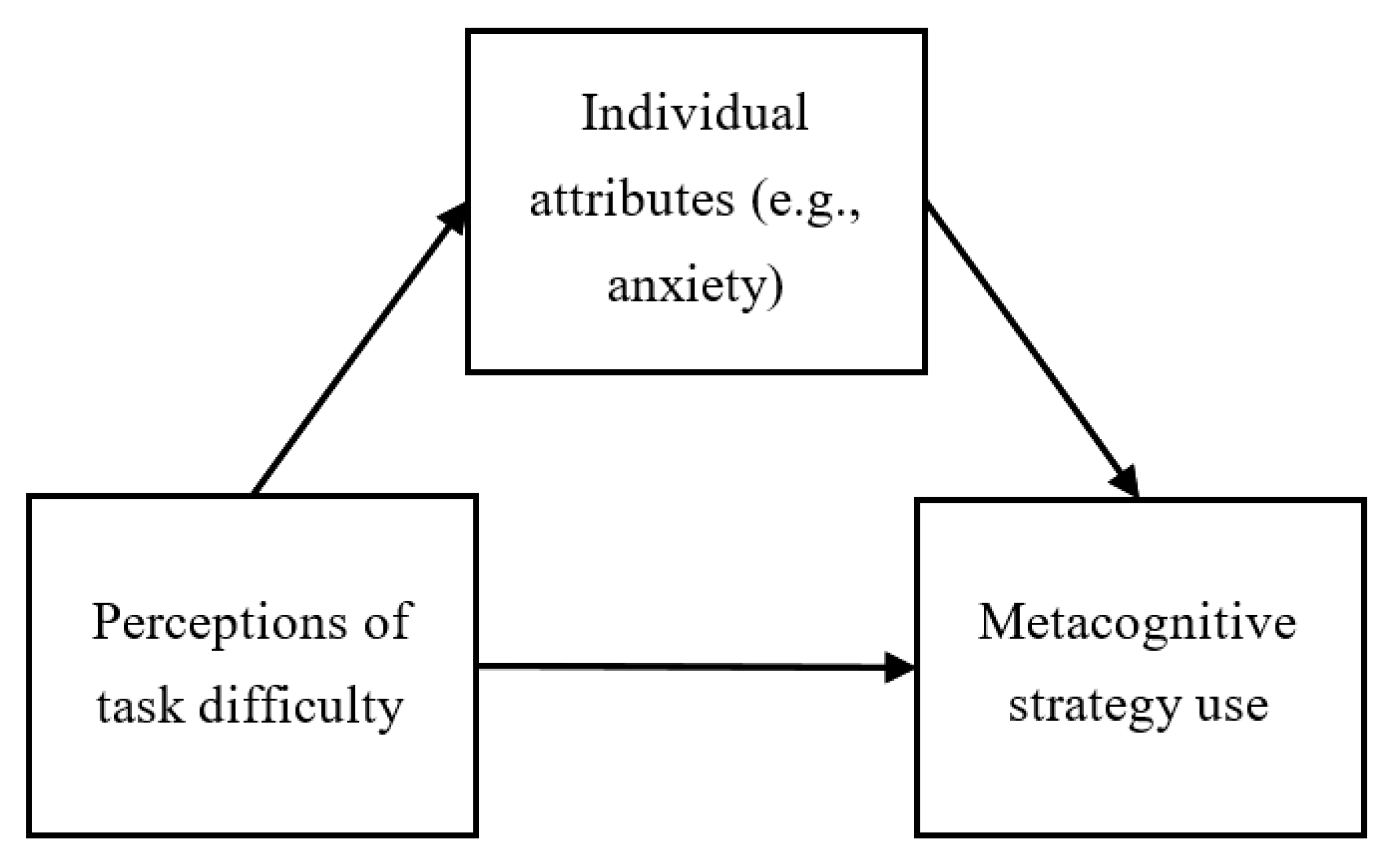
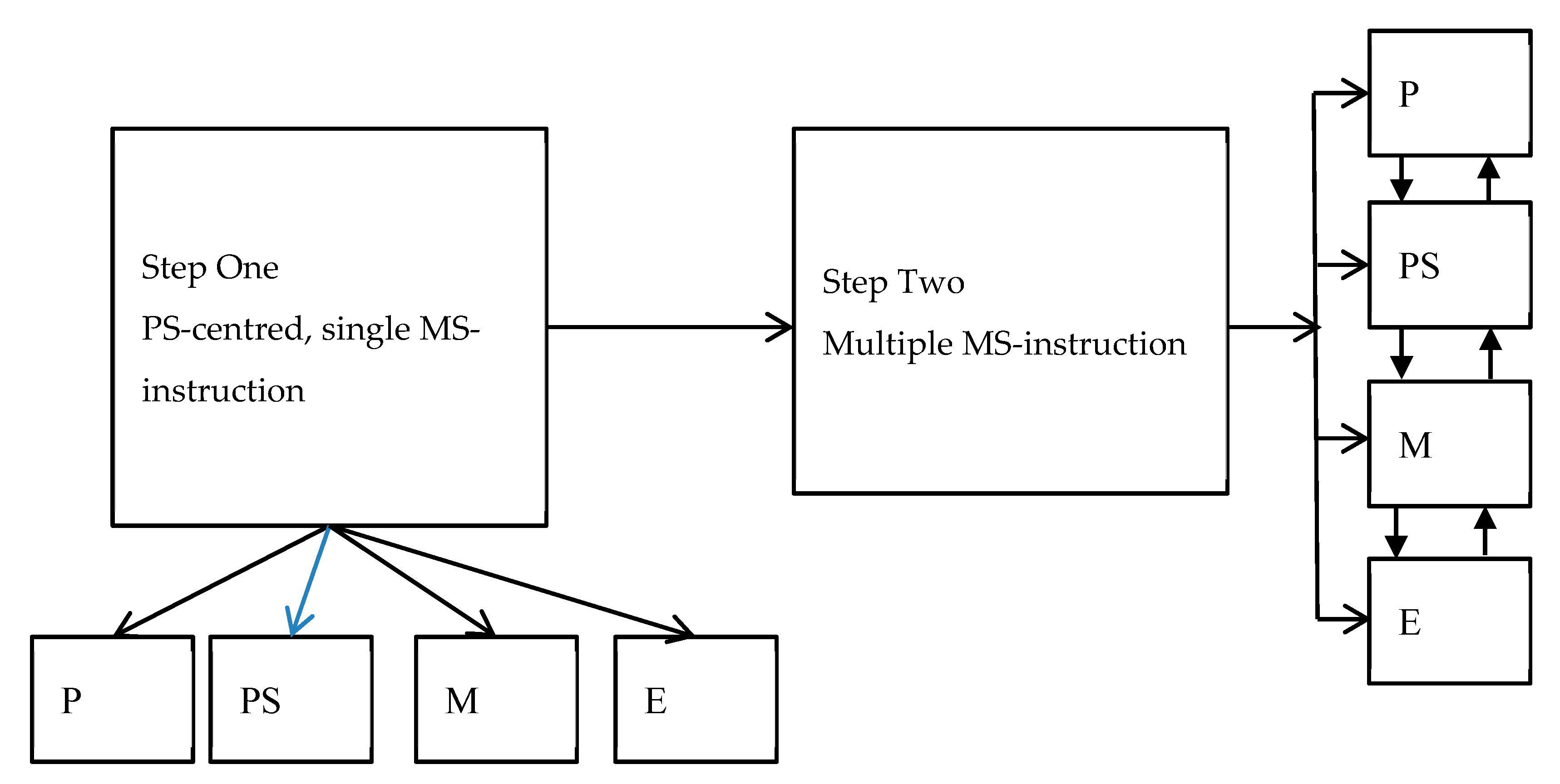
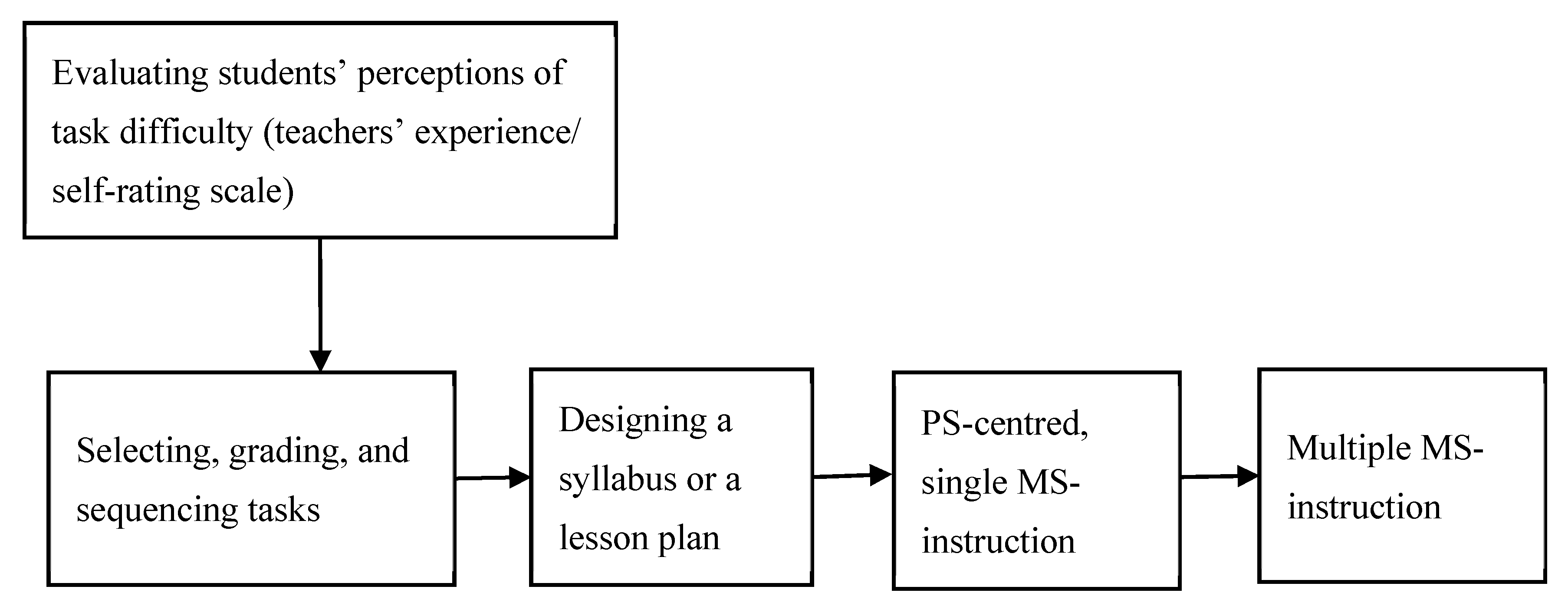
| T | Topic | LS | PT | TT |
|---|---|---|---|---|
| T1 | Campus-life Situations | R-L-S | 30 s | Oral summary |
| T2 | Academic Lectures | R-L-S | 30 s | Illustrating a concept with examples |
| T3 | Campus-life Situations | L-S | 20 s | Providing a solution to a problem |
| T4 | Academic Lectures | L-S | 20 s | Illustrating a concept with examples |
Publisher’s Note: MDPI stays neutral with regard to jurisdictional claims in published maps and institutional affiliations. |
© 2021 by the authors. Licensee MDPI, Basel, Switzerland. This article is an open access article distributed under the terms and conditions of the Creative Commons Attribution (CC BY) license (https://creativecommons.org/licenses/by/4.0/).
Share and Cite
Zhang, W.; Zhang, D.; Zhang, L.J. Metacognitive Instruction for Sustainable Learning: Learners’ Perceptions of Task Difficulty and Use of Metacognitive Strategies in Completing Integrated Speaking Tasks. Sustainability 2021, 13, 6275. https://doi.org/10.3390/su13116275
Zhang W, Zhang D, Zhang LJ. Metacognitive Instruction for Sustainable Learning: Learners’ Perceptions of Task Difficulty and Use of Metacognitive Strategies in Completing Integrated Speaking Tasks. Sustainability. 2021; 13(11):6275. https://doi.org/10.3390/su13116275
Chicago/Turabian StyleZhang, Weiwei, Donglan Zhang, and Lawrence Jun Zhang. 2021. "Metacognitive Instruction for Sustainable Learning: Learners’ Perceptions of Task Difficulty and Use of Metacognitive Strategies in Completing Integrated Speaking Tasks" Sustainability 13, no. 11: 6275. https://doi.org/10.3390/su13116275
APA StyleZhang, W., Zhang, D., & Zhang, L. J. (2021). Metacognitive Instruction for Sustainable Learning: Learners’ Perceptions of Task Difficulty and Use of Metacognitive Strategies in Completing Integrated Speaking Tasks. Sustainability, 13(11), 6275. https://doi.org/10.3390/su13116275







